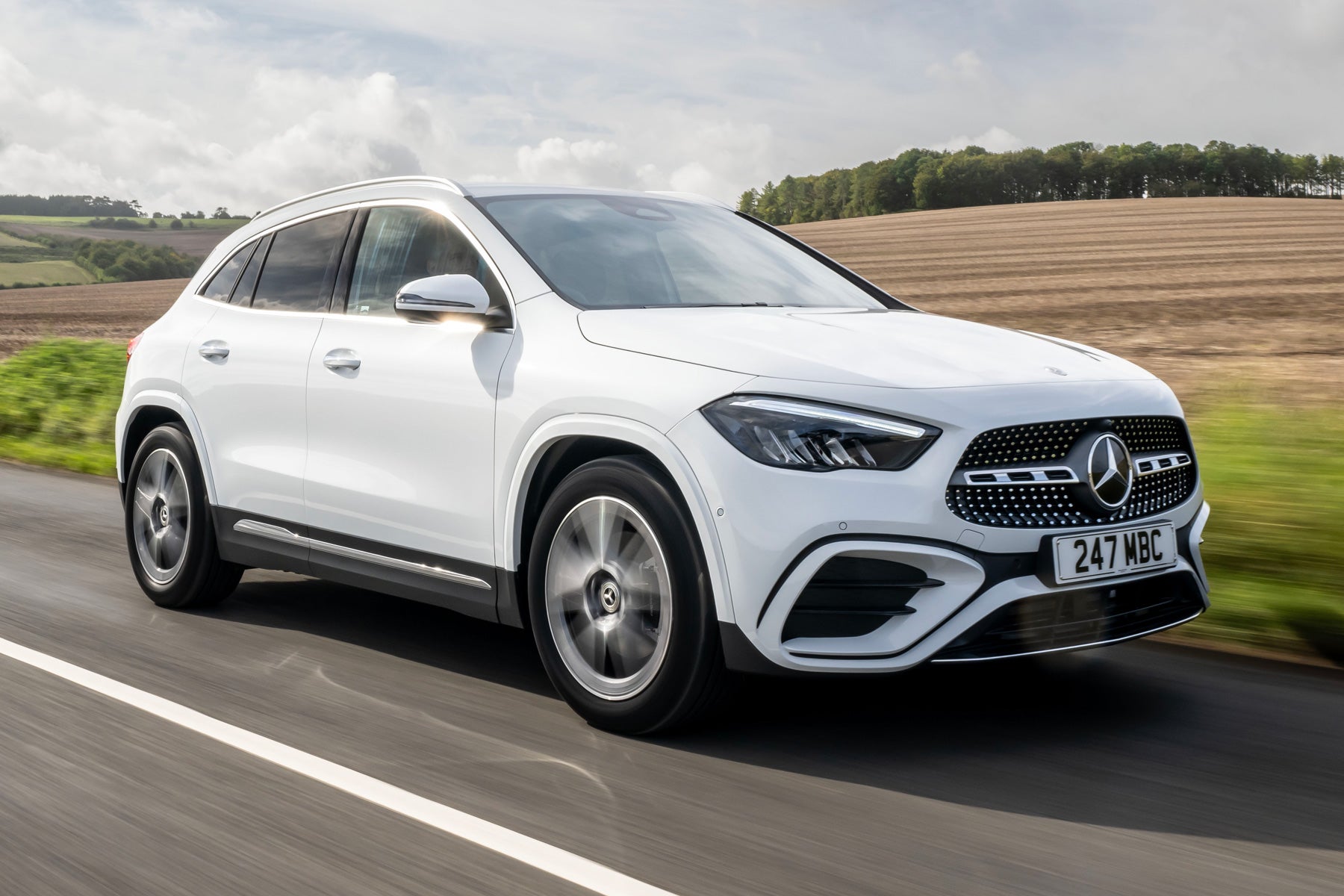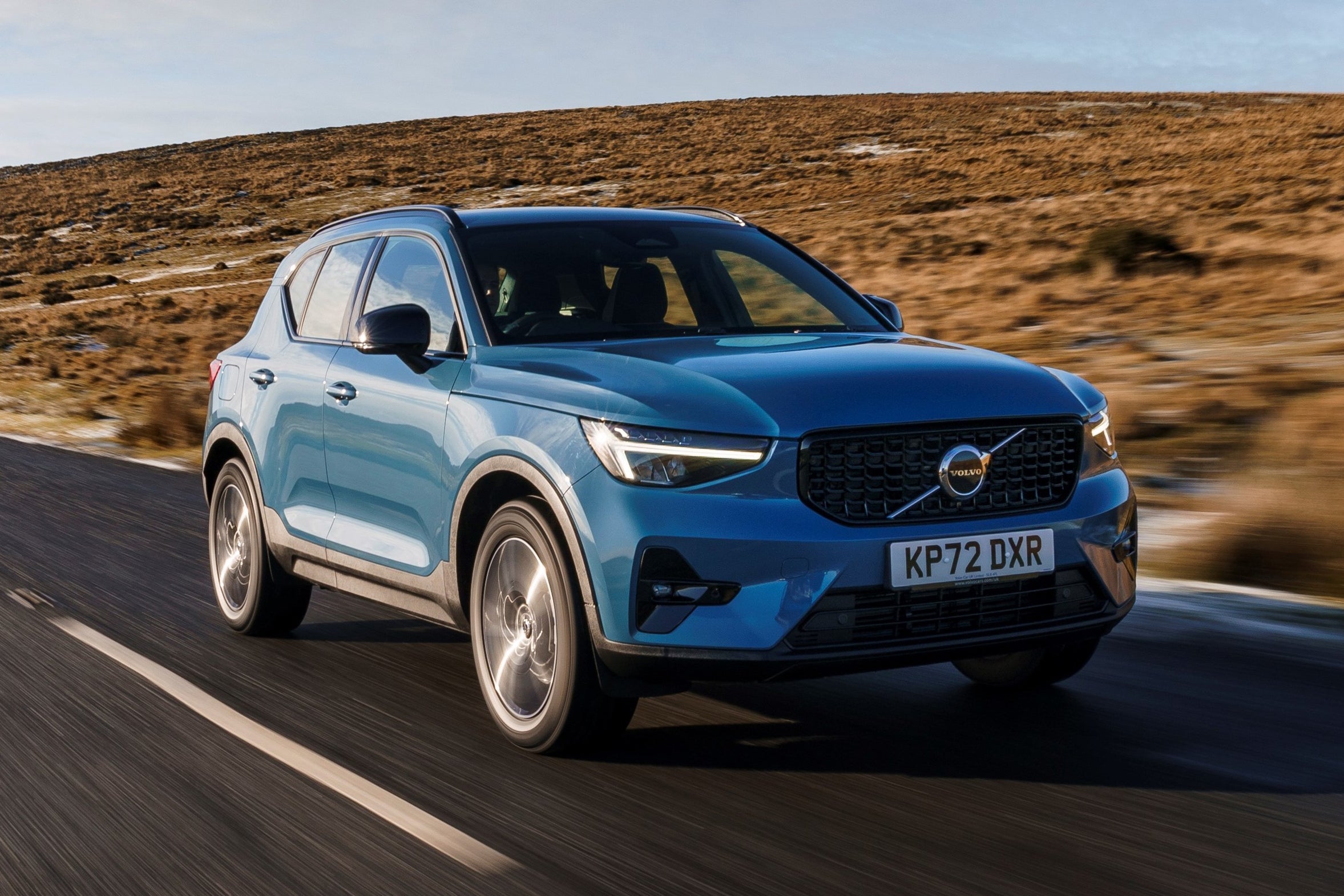BMW X1 Review 2024
Written by Lawrence Allan
Quick overview
Pros
- Spacious and upmarket cabin
- Fun to drive with extensive engine range
- Plug-in hybrid models can officially travel up to 55 miles between charges
Cons
- Can quickly get expensive
- Infotainment isn't as easy to use as before
- Some rivals have a comfier ride
Overall verdict on the BMW X1
"In three generations the BMW X1 has transformed from a bit of a disappointment to one of the best small posh SUVs money can buy. The interior is class-leading in terms of space and the quality of its finish, while the car handles with real agility, and there's an extensive range of engines. However, the ride is on the firm side, and it's not exactly cheap."
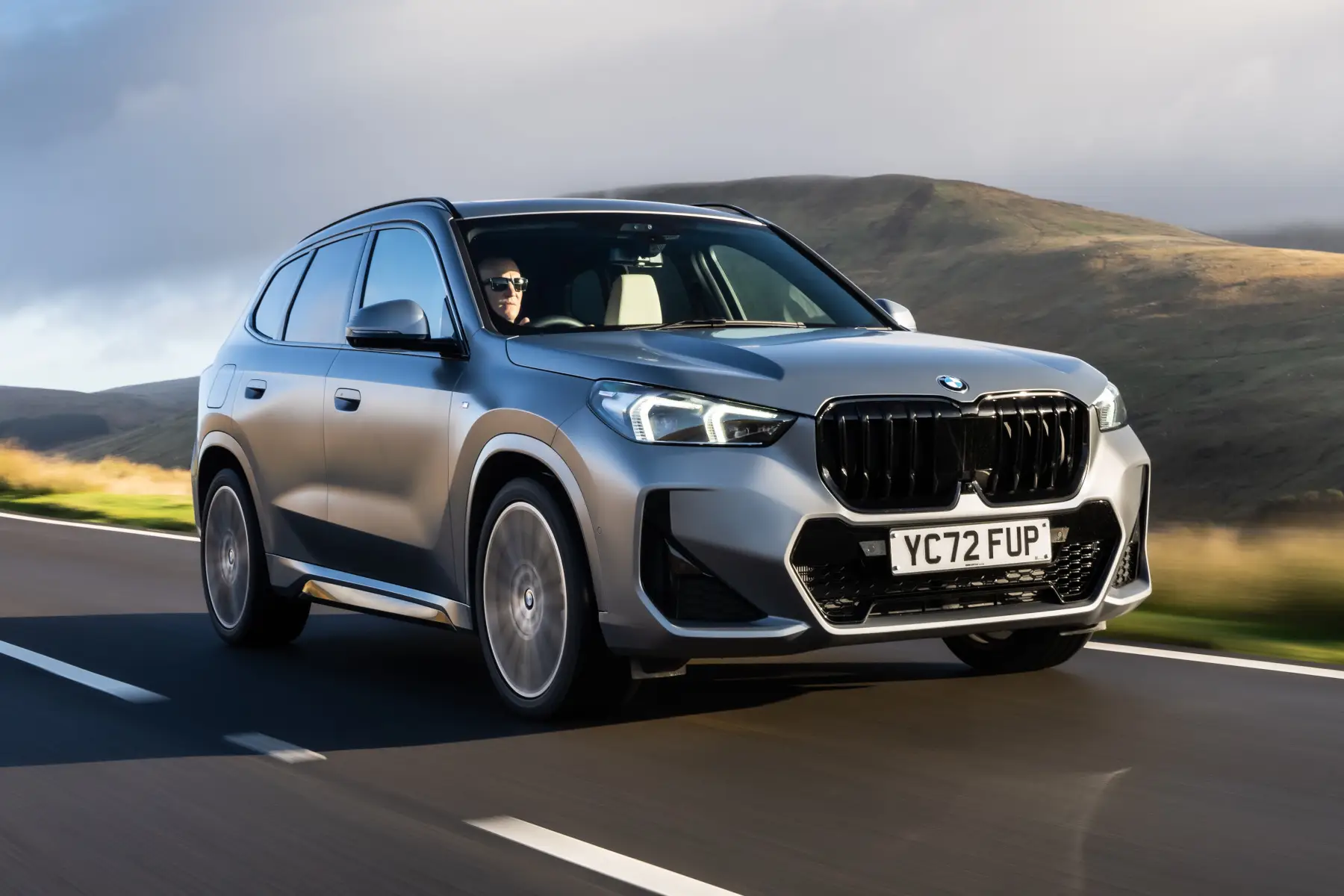
If you're in the market for a practical but not too large family SUV and don't want to compromise on style, the latest BMW X1 is a very compelling alternative to cars like the Volvo XC40, Audi Q3 and Mercedes-Benz GLA. It's more spacious than the previous BMW X1 (and, indeed, most of its rivals), which means it could well be worth the extra cash over mainstream competitors like the Volkswagen Tiguan, Nissan Qashqai and Hyundai Tucson. Find out why in our BMW X1 review.
It's quite impressive how quickly the BMW X1 has evolved in a little over a decade. The first generation car felt (and looked) a bit half-hearted, while the next X1 was a big improvement and became one of the best premium small SUVs around. The stage was set for this all-new 2022 model to rise to top of the class.
Although the new BMW X1's bigger and more muscular exterior look might still divide opinion, it's certainly less love-or-hate than some of the brand's bigger models. It's inside where the latest model has the edge over the competition, though. It features the same modern centre console as the latest BMW 2 Series Active Tourer, as well as BMW's latest fancy dual-screen infotainment setup.
A huge boot is one of the BMW X1's highlights, while an automatic tailgate will also come in handy. Mid-spec models and above come with a neat sliding rear bench as standard, which allows you to prioritise space where you need it. Kids will be more than happy in the back seats of the X1, thanks to a generous amount of space and good visibility out of the side windows, while even big adults won't complain.
It's not just the BMW X1's cabin that has similarities with the 2 Series Active Tourer. It also shares a platform with the people carrier, as well as a chunk of its engine line-up. Significantly, the new X1 is available with petrol, diesel, plug-in hybrid and even electric power, with the latter (badged the BMW iX1) replacing the BMW i3 as a new entry-level electric BMW.
So far, we've driven the petrol BMW X1 xDrive23i and diesel xDrive23d. If you're familiar with BMW nomenclature, you'll recognise that both are all-wheel-drive models (hence 'xDrive'), but you can also get the BMW X1 as a frugal front-wheel-drive SUV. You can't, however, get the new BMW X1 with a manual gearbox, but it's unlikely many buyers will mind.
Both of these models come with a mild amount of electrical assistance, improving fuel economy and providing a small power boost, but you're going to want a plug-in hybrid if you plan to mooch about in near-silence. There are two PHEVs available - the X1 xDrive25e and xDrive30e - both capable of travelling up to 55 miles under electric power alone. That's a considerable distance and more than the Volvo XC40 PHEV can manage.
In typical BMW fashion, the X1 strikes an impressive balance between comfort and sportiness, handling with real agility and composure. The ride is a bit firmer than in a lot of family SUVs, but not to the point of discomfort, in our view. It's also a very easy car to drive, while a host of standard driver-assist technology takes the strain out of longer journeys.
Overall, we reckon the BMW X1 is one of the most convincing all-rounders in the premium family SUV class.
Looking for a used car for sale? We've got 100s of BMW Approved Used Cars for Sale for you to choose from, including a wide range of BMW X1s for sale. If you're looking for the older version, you need our BMW X1 (2015-2021) review.
Is the BMW X1 right for you?
If you're looking for a classy SUV with a superb interior and space for all the family, the BMW X1 is a very good choice. The biggest obstacle you might face in justifying the BMW X1 is, if you're a family buyer, you can pick up a bigger mainstream alternative like the Skoda Kodiaq for the same kind of money.
What’s the best BMW X1 model/engine to choose?
In terms of engine, the 'best' BMW X1 depends on what you're planning to use it for. The diesels will be ideal for those who cover a lot of motorway miles (what they lack in refinement they make up for in efficiency), while the petrols make more sense for those who cover shorter journeys or fancy something a little sportier.
The two plug-in hybrid BMW X1s are perhaps the most impressive, especially with their range of up to 55 miles, but they're expensive to buy or lease and only really make sense if you can charge at home and use the car for a lot of shorter journeys.
No BMW X1 feels sparsely equipped, although you'll need to look at the pricier xLine and M Sport models if you want something that feels that little bit special. This being a premium-brand car, you can quickly rack up a fairly eye-watering list price if you don't restrain yourself with the options list.
What other cars are similar to the BMW X1?
The premium car market is awash with excellent small SUVs. If you're considering a BMW X1, we'd also recommend the Audi Q3 and Mercedes GLA as its key competitors. The Volvo XC40 is a very comfortable and stylish alternative, too, as is the Range Rover Evoque and Alfa Romeo Tonale. If you're after hybrid power, we also rate the latest (albeit larger and pricier) Lexus NX highly.
Not fussed about a posh badge? Then there are some excellent family SUVs that should be on your radar. We'd recommend the Volkswagen Tiguan and Skoda Karoq, while the Mazda CX-5 is a very pretty alternative. Also consider Korean competitors in the form of the Hyundai Tucson and Kia Sportage, while the Nissan Qashqai and Renault Austral are also worth considering.
Comfort and design: BMW X1 interior
"The BMW X1's cabin doesn't cocoon you like the old car's. Instead, it feels airy and spacious, while the standard twin infotainment screens mean it looks ultra modern. It's one of our favourite smaller SUV cabins."
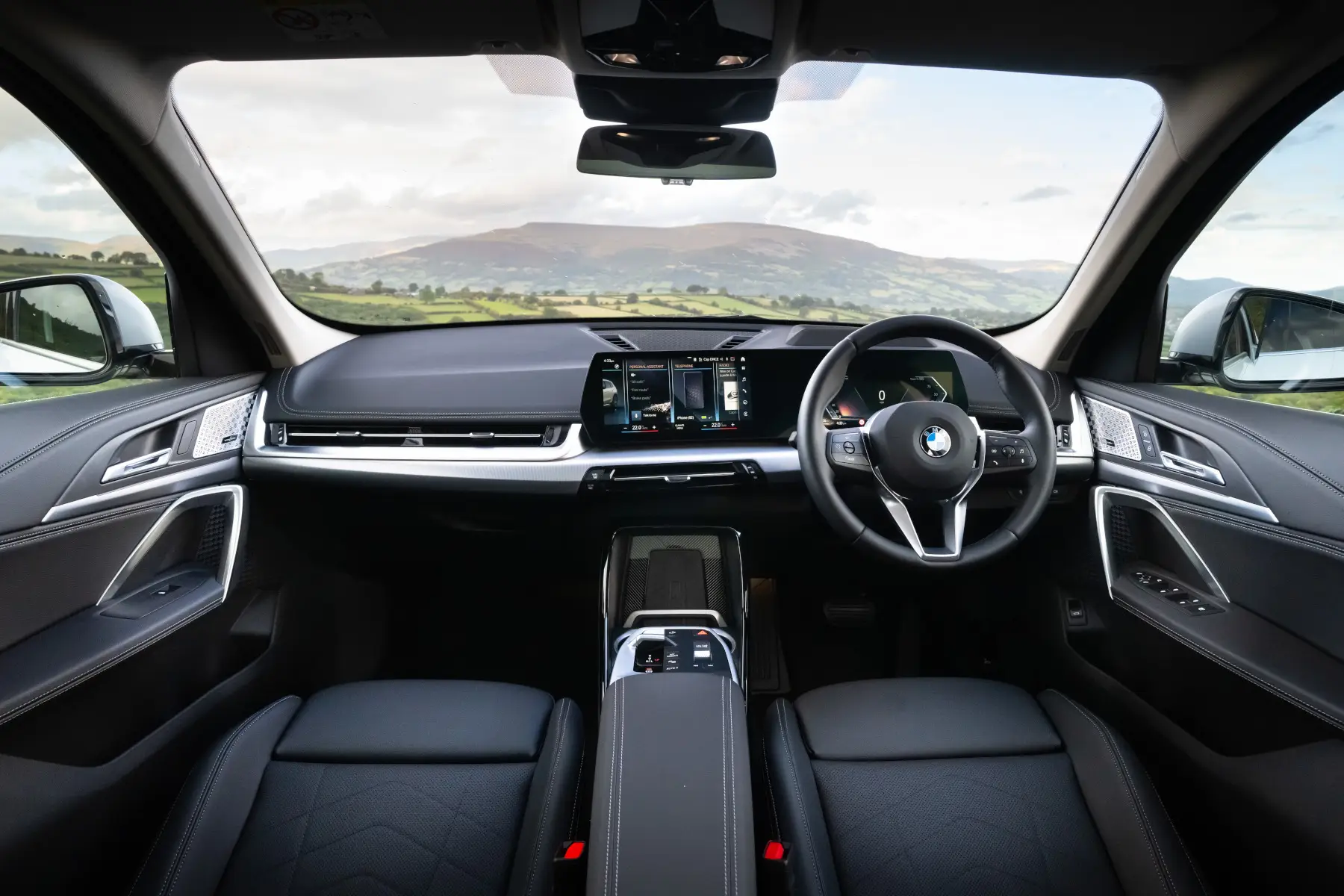
The new X1 feels a lot like the latest BMW 2 Series Active Tourer inside. You get a deep windscreen and a (kind of) floating centre console, which adds to the general feeling of space. You don't sit particularly high up for an SUV, although the driving position is higher than in a hatchback like the 1 Series. There is a fair bit of adjustment in the seats if you do want to see over hedgerows, though.
We found the seats to be comfortable and supportive even for extended periods behind the wheel, although you might want to look for an X1 with the additional lumbar support (including a massage function) for extra comfort. There's a typical BMW feeling of driver focus in the front, with the centre console and displays angled towards you. But there's also a feeling of space and airiness that you'd typically associate with MPVs.
You get the usual thick-rimmed BMW steering wheel which can potentially obscure areas of the dial display for drivers of a certain size, but it's not a big issue. The latest infotainment is slick and feature-packed (aside from one criticism... more on that below). The interior feels of very high quality, too, while features like aluminium inlays and blue stitching (depending on trim level) brighten up the cabin.
Quality and finish
The BMW X1 feels as posh as you'd expect from a baby Beemer, with lots of dense, high-class materials and a smart frameless infotainment system. It's been designed with families in mind, much like the latest 2 Series Active Tourer, so there are a few hard plastics that will cope well with being kicked and prodded by younger family members.
As is always the case, the more you spend on a BMW X1, the posher it'll feel inside. xLine models come with BMW's fancy Sensatec fake leather and gloss back interior highlights, while the BMW X1 M Sport adds some sporty Alcantara seat coverings with blue stitching as well as aluminium interior highlights. Overall, it's probably the best blend of design, finish and practicality in the premium small SUV class.
Infotainment: Touchscreen, USB, nav and stereo in the BMW X1
The new BMW X1 gets the brand's latest eighth-generation iDrive infotainment system. Impressively, this is standard across the range, combining a 10.25-inch digital driver display with a 10.7-inch central touchscreen display. It's a really slick system to use, with sharp graphics and fast responses.
You can also option up an 'augmented reality' feature for the navigation system. This takes a camera feed of the road ahead and overlays it with arrow directions to show you precisely where to turn. It sounds distracting, but it's cleverly done to point you down the turning or off a roundabout at the right place without getting in the way of your actual view of the road. Bear in mind this doesn't work if you're using Google Maps or Waze through Apple CarPlay or Android Auto, however.
Our only real criticism is you don't get a rotary controller like you do on a BMW 3 Series. Instead, you have to touch the screen itself, which is a little more distracting on the move. Some may not find that a big issue, but it just makes things a little more fiddly at times in our experience. The same applies to the removal of physical buttons and knobs for the climate control stack. Temperature controls are visible on the central screen at all times, but adjusting things in more detail is a bit of a faff.
One way around this is by using BMW's Intelligent Personal Assistant. This is one of the better voice-activated systems we've sampled, responding to 'hey BMW' commands. It's not just for operating the infotainment, either - you can tell it to open a window, turn on the heated seats or adjust the climate control.
The BMW X1 comes with a handy mobile phone tray in the front of the centre console. This features wireless charging and a clasp to hold your phone in place - oddly for some it's positioned vertically rather than horizontally as you'll find in most other cars, hence why it needs a clasp to hold your phone.
Space and practicality: BMW X1 boot space
In terms of exterior dimensions, the new BMW X1 is 4500mm long, 1845mm wide and 1642mm tall - respective increases of 53mm, 24mm and 44mm over the old car. There's an extra 22mm between the front and rear wheels, too.
In plain English, the BMW X1 is pretty big for a car in this class - larger in length than the Volvo XC40, Mercedes-Benz GLA and Audi Q3 by a decent margin. No, it's not as big as a seven-seat Skoda Kodiaq, but it does the whole 'family car' thing better than the old BMW X1. Of course, that increase in external size may be a burden rather than a bonus for some, particularly when it comes to parking, but we didn't find it particularly cumbersome, even on tight country roads.
The BMW X1's boot can carry up to 540 litres of luggage, which is a very good amount for the class - much better than a Volvo XC40 and bigger even than the Nissan Qashqai's boot. Again, you'd be forgiven for forgetting that this is BMW's smallest SUV. You get plenty of underfloor storage, while a standard-fit electric tailgate makes life easier when you've got your hands full with shopping.
On BMW X1 xLine models and above, a sliding rear bench is fitted as standard. That means you can prioritise legroom for your rear passengers or luggage space in the boot. If you're not carrying anyone in the back, the rear seats drop in a practical 40/20/40 split to provide up to 1600 litres of luggage space. One caveat is that we haven't yet tried the plug-in hybrid X1, which is likely to have slightly less boot capacity.
When the seats are in use, rear passengers ought to be pretty happy. You get more head- and legroom than in key competitors, and even the middle seat doesn't feel quite as cramped as some do. Adult passengers can spend plenty of time here without feeling hemmed-in - they'll probably assume you've bought the bigger BMW X3.
The front feels extremely spacious, too, helped by a floating centre console and a relatively low dashboard (a bit like in the BMW 2 Series Active Tourer). There's loads of adjustment in the seats: you can crank them up for a high seating position, if you like, or lower them for extra headroom.
Handling and ride quality: What is the BMW X1 like to drive?
"BMWs tend to be a bit sportier than their competitors and, while the X1 doesn't handle like a sports car, it certainly feels more planted than most - if not all - of its small SUV rivals. "
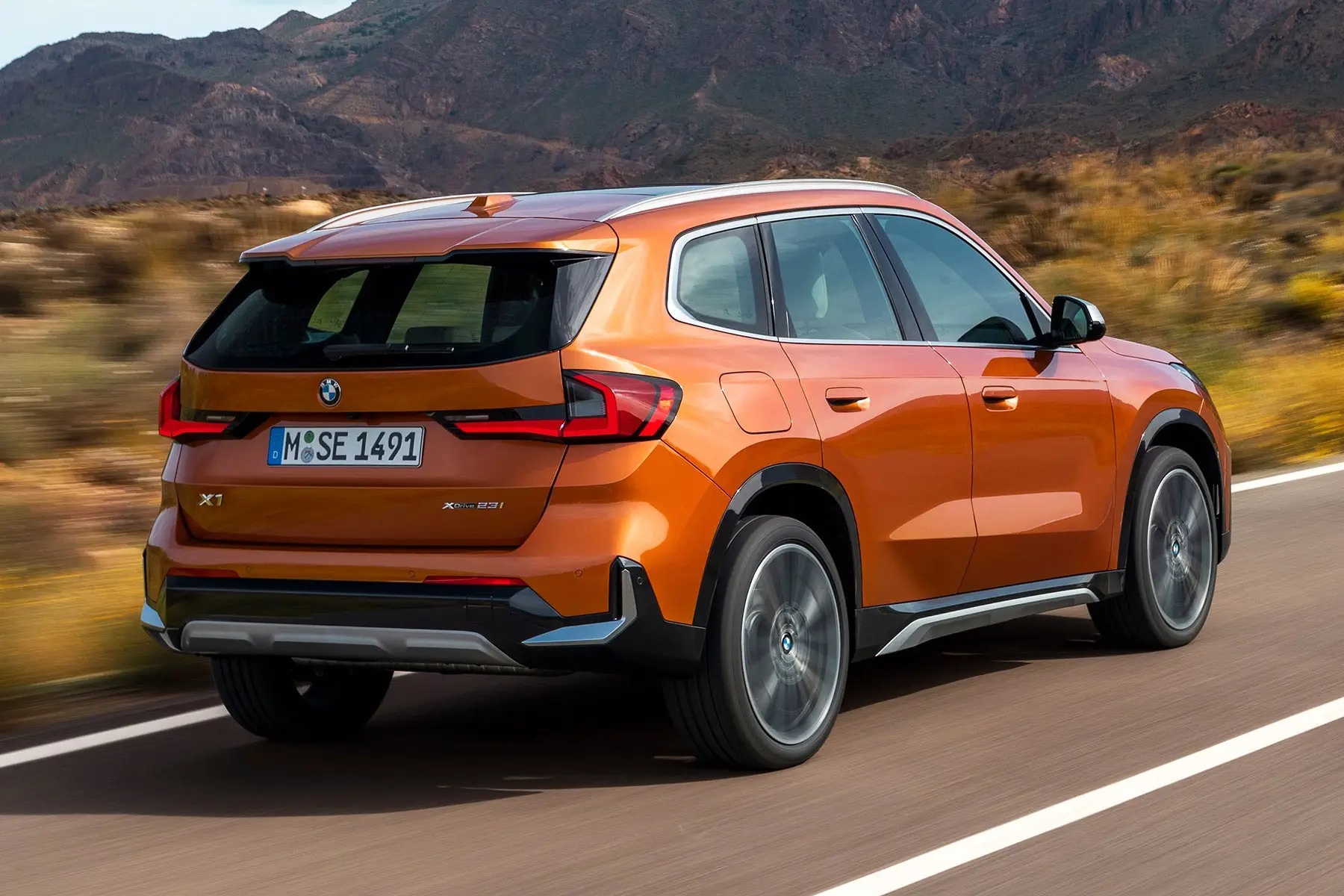
Even though we've only driven the new BMW X1 in its sportiest, least comfort-focused M Sport form, we reckon it strikes a good balance between isolating passengers from the gnarliest road surfaces and controlling body movements to make the car feel sharp and agile. We've some reservations, though.
The BMW X1 M Sport models we drove came with the M-Adaptive suspension, which allows you to move between softer and firmer damper settings. However, our test cars also came with the largest 20-inch alloy wheels. While at no point did we find the cars uncomfortable, the underlying firmness may make it a less relaxing car to travel in than, say, the softly sprung Volvo XC40. We reckon smaller diameter wheels will smooth things out a bit.
Keen drivers, however, will likely be impressed. Whereas an XC40 feels a bit wallowy and unsettled on faster, undulating roads, the X1 feels very well sorted indeed. Okay, so it isn't a 3 Series, but you'd be hard pressed to enjoy a twisty road more in any other family-focused SUV.
The steering isn't brimming with feel but it's very accurate and quite direct. There's loads of grip, while BMW's impressive xDrive all-wheel-drive system is on hand in most versions for those who want a little more reassurance (ideal if you live in a rural area).
It's also an easy car to drive at lower speeds, helped by the high seating position providing decent visibility and a long list of driver-assist features on hand to act as a second pair of eyes.
What engines and gearboxes are available in the BMW X1?
The BMW X1 range certainly has something to cater for every buyer - provided you're not after a manual gearbox, anyway. That's no bad thing as an impressive eight-speed automatic transmission is standard across all X1 models.
The cheapest BMW X1 is powered by a fairly low-powered 2.0-litre diesel, badged the sDrive18d. This is a front-wheel-drive model with 150PS and 360Nm of torque, taking it to 62mph in a perfectly acceptable 8.9 seconds. Thrilling it is not, but its impressive efficiency will make it the X1 of choice for high-mileage drivers.
Looking for a diesel with a bit more grunt? You'll need the BMW X1 xDrive23d, which packs 211PS and 400Nm of torque, giving it a 0-62mph time of 7.4 seconds. BMW aficionados will realise the 'xDrive' part of its name means it comes with BMW's all-wheel drive system, on hand to shift torque to the rear wheels when necessary to increase traction.
The petrol offerings kick off with the sDrive20i, which uses a 1.5-litre petrol engine to deliver 170PS, giving a 0-62mph time of 8.3 seconds, but we haven't tried it yet so can't tell you what it feels like. The BMW X1 xDrive23i uses a 218PS 2.0-litre petrol engine to accelerate to 62mph in a fairly sprightly 7.1 seconds, and it feels fairly potent. Both petrol engines are aided by mild-hybrid electrical assistance.
Of course, an SUV needs to be offered with hybrid power to stand out in this day and age. While you can't buy a BMW X1 as a 'self-charging' hybrid, there are two plug-in hybrids available. We haven't tried either, but they both pair a 1.5-litre petrol engine with an electric motor and relatively large (by hybrid standards) 7.4kWh battery, providing a very competitive electric range of up to 55 miles. If you want more than that, you'll need the pure-electric BMW iX1.
Refinement and noise levels
We were actually quite surprised by how vocal the 2.0-litre petrol engine in our BMW X1 xDrive23i test car was. Maybe that's because it does have a slightly sporty bent but still, the four-cylinder engine doesn't whisper so much as shout - premium rivals are usually quieter.
The diesel BMW X1 sDrive18d doesn't fare much better in this regard, either. We've only driven it for a short period but it rattles quite distinctively and, if anything, highlighted how quiet and refined the electric BMW iX1 is.
Safety equipment: How safe is the BMW X1?
The BMW X1 comes with the brand's latest front-collision warning system with brake intervention. This means it can detect a potential crash (with another vehicle, pedestrian or cyclist) and warn you to take evasive action. If the driver doesn't respond, it'll automatically apply the brakes to prevent a collision, or at least reduce the severity.
A Lane Departure Warning system is also standard, as is an Active Park Distance Control feature which, as well as alerting you to obstacles when parking, can also apply the brakes to prevent a low-speed scrape. The BMW X1 also comes with a reversing camera as standard, while the latest Parking Assist can help control the steering as you negotiate a parking space.
The BMW X1 was awarded five stars by crash test experts Euro NCAP in 2022. All-round scores were very good, with safety assist scores particularly strong.
MPG and fuel costs: What does a BMW X1 cost to run?
"Provided you buy the right BMW X1 to suit your needs, it really shouldn't cost very much to run at all."
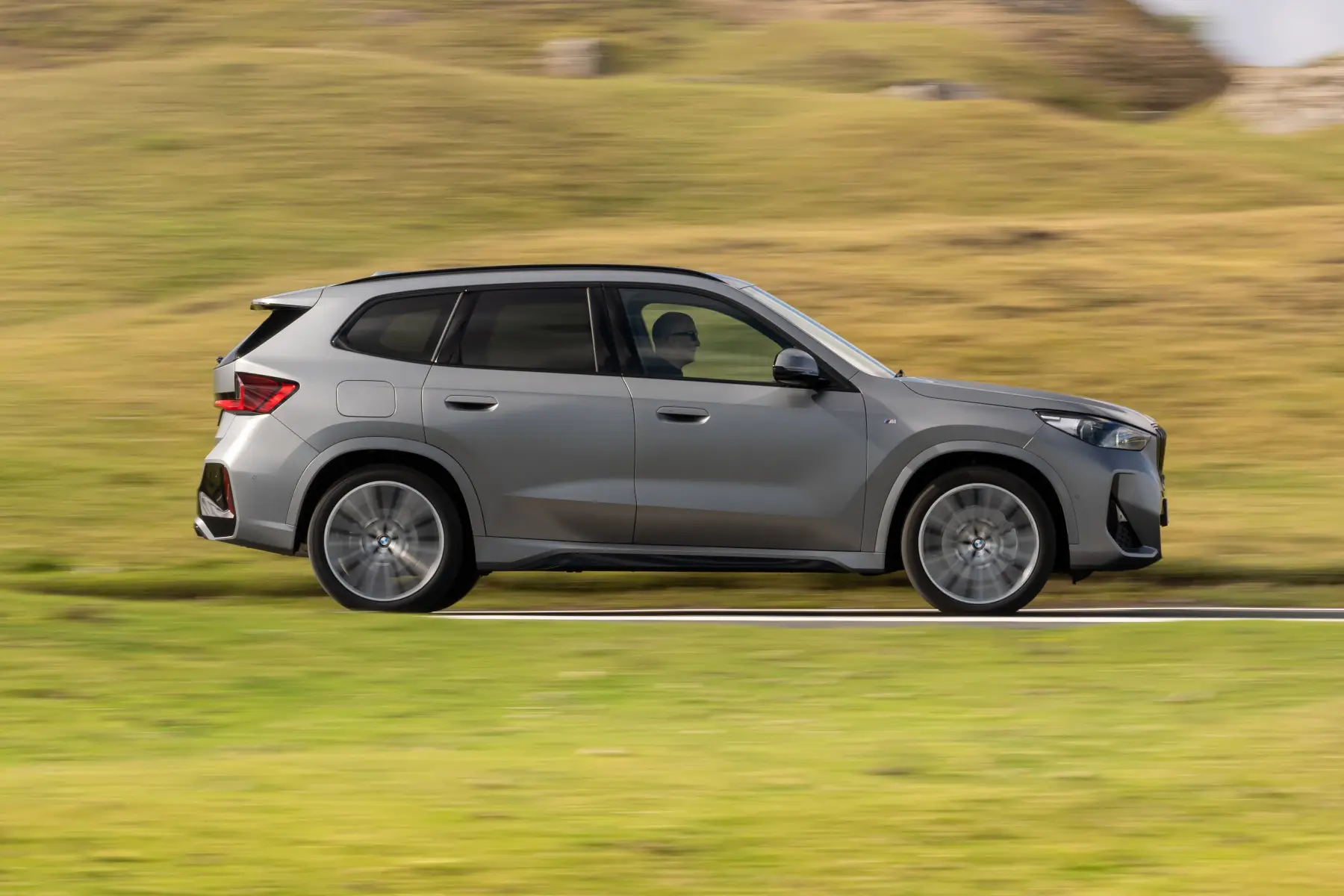
The plug-in hybrid models are by far the most efficient on paper, with the BMW X1 xDrive25e and xDrive30e returning up to 353.1mpg in official WLTP tests. Take these figures with a pinch of salt, though, as the efficiency of PHEVs depends a lot on how you use them.
Both PHEVs have an electric-only range figure of up to 55 miles, though, which is quite a considerable distance before the petrol engine needs to kick in. If you cover a lot of short journeys and have access to off-road parking (with an electric car charger or at least a three-pin socket), the plug-in hybrids will be almost as cheap to run as the electric BMW iX1.
For those drivers who cover long journeys, we'd recommend one of the diesel-powered BMW X1 models. Sure, diesel might be out of fashion, but it's still the most economical way of sitting at motorway speeds for extended periods. Officially, the X1 xDrive23d returns up to 58.9mpg while the sDrive18d manages 57.7mpg.
Unsurprisingly, the petrol BMW X1 xDrive23i is the thirstiest of the range, officially returning up to 43.5mpg. Not bad for a fairly powerful petrol SUV, mind.
How reliable is the BMW X1?
BMW's performance in the latest HonestJohn.co.uk Satisfaction Index was pretty average, ranking in position 20 out of 30. That's lower than you'd expect from a premium brand yet still higher than rivals including Audi and Alfa Romeo.
We're not aware of any common issues with the latest BMW X1, however, and its engines are proving to be pretty dependable in other BMWs. Servicing costs might be a little higher than mainstream competitors but the BMW X1 shouldn't leave you stranded at the side of the road.
Insurance groups and costs
For the cheapest insurance, you'll need one of the less powerful BMW X1 models. Even these might be a little pricey to insure if you're a young or inexperienced driver. The BMW X1 sDrive18d Sport ought to be the cheapest to insure, sitting in insurance group 24, but we'd always recommend shopping around for quotes.
VED car tax: What is the annual road tax on a BMW X1?
The amount you'll pay in road tax for the BMW X1 depends which engine you go for and even how much the car cost when it was new.
A regular petrol or diesel BMW X1 will cost £180 a year in tax. However, cars with a list price of more than £40,000 when new (which is most of them) are subject to an additional 'premium car' annual surcharge of £390 for five years from the second time the vehicle's taxed. It's worth double checking the original list price of any car you're buying - the price you actually pay is irrelevant in the eyes of the DVLA.
Plug-in hybrid models qualify for a £10/year discount. But if you really want to save money in road tax, you'll need to look at the electric BMW iX1. Like all pure-electric models, the iX1 currently qualifies for free road tax.
How much should you be paying for a used BMW X1?
"Prices for a new BMW X1 start from just under £35,000 but you'll soon spend more than that, once you've been tempted by the flashier trim levels or desirable option packs."
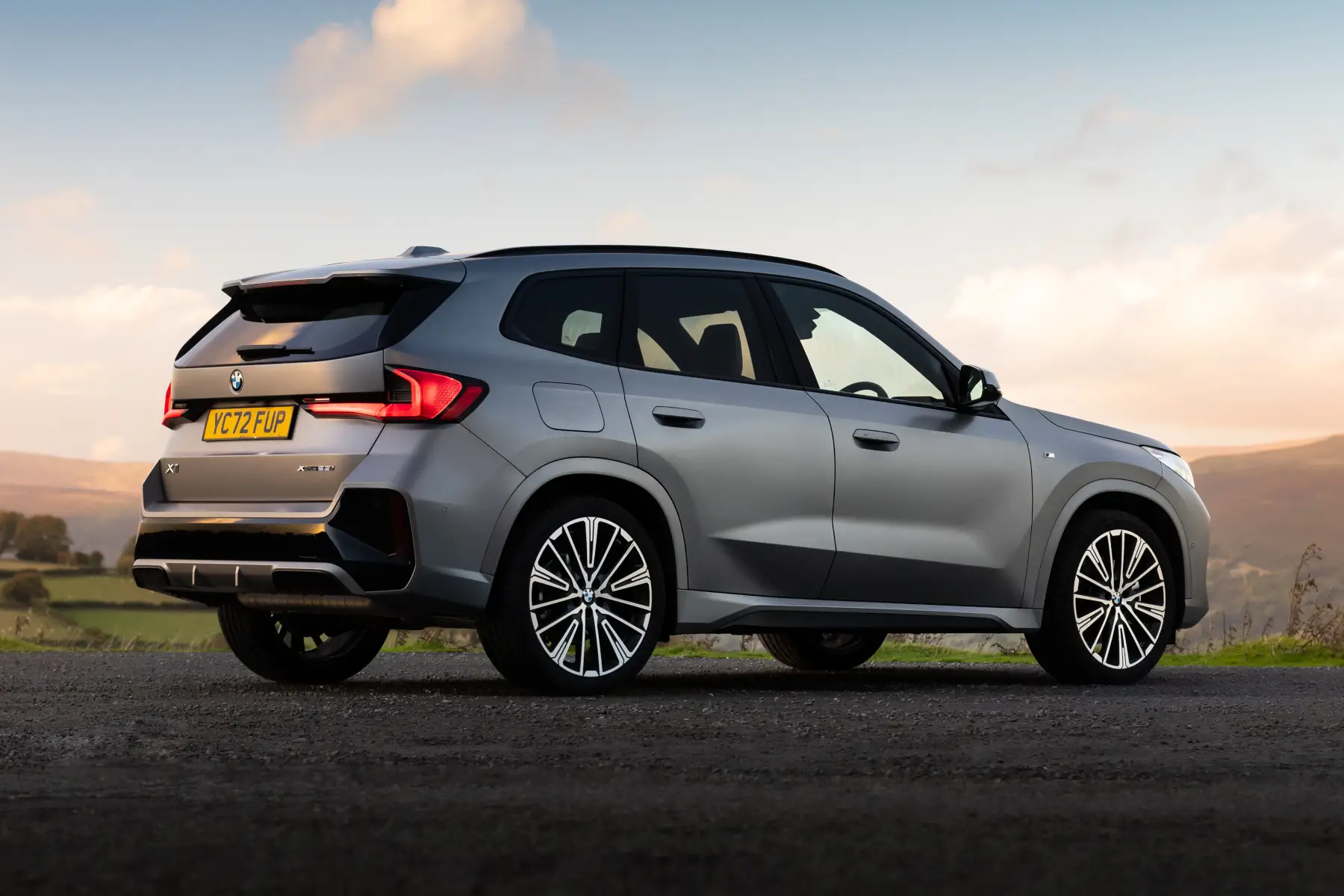
While that might seems steep, remember that new pricing for all cars has increased noticeably in recent years, and the X1 is broadly in line with rivals in that respect once you consider the engines and equipment on offer.
The most affordable model is initially the BMW X1 sDrive20i Sport, while you'll pay a bit more for the diesel sDrive18d. The plug-in hybrid model is significantly more expensive, starting from more than £42,000. That price premium will buy you a considerable amount of petrol or diesel.
BMWs tend to hold their value very well and, in the current climate, it's no surprise to see dealers reluctant to offer huge savings on pre-registered or nearly-new X1s. That said, if you're keen to skip the queue, we have seen as-new BMW X1 models in showrooms with four-figure savings over list price.
Trim levels and standard equipment
Standard equipment on the BMW X1 Sport includes LED lights, 17-inch alloy wheels and an automatic tailgate. Inside, the BMW X1 Sport comes with a sport leather steering wheel and two-zone climate control, while infotainment is provided by a curved display merging a 10.25-inch information screen with a 10.7-inch central touchscreen. The BMW X1 Sport also features the Parking Assistant pack (including Active Park Distance Control and a Reversing Assist Camera) as well as cruise control.
Highlights of the BMW X1 xLine include dark grey mirror caps, a radiator grille finished in matt aluminium and aluminium door sills. Inside, the xLine features perforated Sensatec (faux-leather) seats and high-gloss black interior trim.
The BMW X1 M Sport comes with 19-inch alloy wheels, Alcantara/Sensatec seats finished in black with blue stitching and aluminium interior trim.
Ask the heycar experts: common questions
Should I buy a BMW X1?
How much is a BMW X1?
Is the BMW X1 an estate or an SUV?
Stay up to speed with great offers plus the latest car news and reviews
Keep me updated by email with the latest advice, news and offers from heycar.
By submitting you agree to our privacy policy


